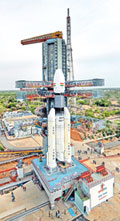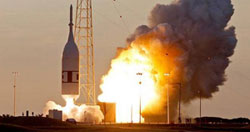July 2019 Science and Technology
Sakshi Education

- Chandrayaan 2 to be launched from Sriharikota today (22 July)
India’s expedition to the moon is all set to begin on 22 July, 2019 with the launch of Chandrayaan-2 by using the heavy-lift launch vehicle GSLV-Mark-Three.
The rocket carrying the prestigious probe will be ignited at 2.43 pm from the Satish Dhawan Space Centre at Sriharikota in Andhra Pradesh, some 90 kilometres off Chennai.
Indian Space Research Organisation scientists said, the 20-hour countdown for the launch began last evening at 6.43 pm and is progressing smoothly.
The launch rehearsal has been done by the scientists and engineers of the ISRO at Sriharikota on Sunday.
The national space agency has said all the parameters during the rehearsal were found to be normal.
That all preparatory arrangements have been put in place for the mission.
Originally Chandrayaan-2 was planned to be launched on the 15th of this month. However, a technical snag was detected less than an hour before its scheduled lift-off, forcing the mission to be halted.
To make up for the loss of seven days due to the delay in the launch, the flight duration of Chandrayaan-2 from the earth to the moon has been reduced from 54 days to 48 days by tweaking the flight path. Its lander will descend on the moon by September 7 as planned earlier.
The scientists would perform fifteen crucial manoeuvres to navigate the probe from an earth-bound elliptical orbit to the surface of the moon.
Total cost of the mission is worked out to be 978 crore rupees.
The mission objectives of Chandrayaan-2 include studying mineralogy and chemical composition of lunar soil, to search for water or ice in the near-South Pole of the moon, examining its atmosphere, studying lunar seismic activities and to carry out mapping of the moon using high-resolution cameras.
One of its main goals is to make a soft-landing of an indigenous lander on the uncharted territory of the moon.
The mission Chandrayaan-2 has evoked huge interest among the people of the nation.
It is evident from the booking of all the slots meant for the public to view the launch, within minutes of opening the online window for registration. In short, Chandrayaan-2 is set to carry the dreams of over 1.3 billion hearts to the moon, besides yielding rich dividends for the nation’s scientific pursuit and nourishing scientific attitude.
- India's first space tech park in Kerala
The Kerala government will set up India’s first space tech park at Thiruvananthapuram's Knowledge City.
The move is aimed at making the city a manufacturing hub for space-related technology.
A space museum named after former President of India Dr APJ Abdul Kalam will also be a part of the infrastructure.
The entire investment in the park will be made by the Vikram Sarabhai Space Centre.
- World Media hails India's successful launch of Chandrayaan 2
International Media have hailed India's successful launch of its second moon mission Chandrayaan-2.
The Washington Post commented that India's low-cost, homegrown technology that has powered its space programme is a source of national pride and inspiration. Quoting experts, the Post said the successful second attempt so soon after the aborted launch highlights ISRO's confidence in its technological capabilities, which have not been hamstrung by its paltry 1.8 billion US Dollar budget.
In comparison, NASA received USD 21.5 billion in funds this year, the Post noted.
The New York Times commented that if the rest of the mission goes as well, India will become the fourth nation - after the United States, Russia and China - to land on the moon, more than 200,000 miles away.
Its target is a region near the mysterious South Pole, where no other missions have explored.
This mission is significant for India, the country wants to become a major space player and put Indian astronauts in space by 2022.
Leading British newspaper, The Guardian reported that Chandrayaan-2 aims to become the first mission to conduct a surface landing on the lunar south pole region, where it will collect crucial information about the moon's composition.
The Times newspaper of London reported that India has launched a rocket to the moon, aiming to become the fourth country to land a craft on the lunar surface and cement its emergence as a leading space power.
BBC commented that it is the most complex mission ever attempted by India's space agency.
China's state-run Xinhua news agency gave extensive coverage to Chandrayaan-2's launch and reactions of President Ram Nath Kovind and Prime Minister Narendra Modi.
Pakistan's leading newspapers on their websites displayed the news of the launch by international news agencies.
- ISRO has launched Chandrayaan 2 successfully from the Satish Dhawan Space Centre in Sriharikota on 22 July
Indian Space Research Organization (ISRO), the Indian Space agency, has launched Chandrayaan-2 successfully into the elliptical Earth orbit from the Satish Dhawan Space Centre in Sriharikota on 22 July.
The spacecraft was carried by the Geosynchronous Satellite Launch Vehicle GSLV MkIII-M1. It was India’s most challenging and ambitious mission. It is expected that Spacecraft will try to land a rover near the Southpole of the Moon on 7 September 2019, in 48 days.
If the spacecraft lands softly on the Moon, India will be the fourth country to successfully carry out such mission. The three countries that have launched the spacecraft successfully are US, Russia and China.
The Chandrayaan-2 spacecraft weighs around 3.8 tonnes. The total estimated cost for the mission was Rs.978 crore that is Rs.603 crore for the space segment and Rs.375 crore for the launch.
The space segment of Chandrayaan-2 includes
- an orbiter,
- a lander named Vikram
- a rover named Pragyan.
For the first time ever, an Indian space mission is being led by women scientists. Muthayya Vanitha, as a project director, has led the mission from the start.
ISRO's GSLV Mk III is a three-stage launch vehicle. The vehicle consist of two solid strap-ons, a core liquid booster and a cryogenic upper stage. The vehicle was designed, so that it can carry 4 ton class of satellites into Geosynchronous Transfer Orbit (GTO) or about 10 tons to Low Earth Orbit (LEO).
- NASA prepares to send first woman and next man on Moon in 2024
NASA marked the 50th anniversary of the historic first Moon landing.
The US space agency is preparing to take its next giant leap with the ambitious Artemis program is named after the twin sister of Apollo.
She is the Goddess of the Moon and the hunt.
The program to return astronauts to the lunar surface is planned to launch by 2024.
NASA plans to explore regions of the Moon visited the mysteries of the universe and test the technology that will extend the bounds of humanity farther into the Solar System.
On the lunar surface water ice and other natural resources will further enable deep space travel.
- CCMB unveils new Next Gen Sequencing facility
The Centre for Cellular and Molecular Biology (CCMB) received a state-of-the-art facility for its genomic studies division which was inaugurated by Union Minister for Health and Family Welfare Dr Harsh Vardhan on July 20.
The minister also laid the foundation stone for a new skill training and lecture hall complex on the occasion. The NGS Facility promises to sequence up to 30 human genomes in a day and help researchers to individually tag genomes of up to 80,000 cells in eight minutes.
NGS would include technology for high genome sequencing and also diagnostic sequencing of clinical samples. It is 4th such facility in the country. It is a state-of-the-art genome sequencing facility that can sequence 18,000 samples in. It is acquired at a cost of Rs.8 crore. It can sequence 30 human genomes a day, It would costs around Rs.1 lakh to sequence one genome using this facility.
There is a need to develop Scientific Social Responsibility (SSR) and ensure that research is transferred to industry, and public at large.
NSG facility would help in generating large-scale genomic data from Indian populations, which was critical for genetic diagnosis and therapy.
NGS would help prenatal genetic screening and counseling, thus generating large scale genomic data critical for diagnosis and therapy.
It would especially help patients suffering from rare genetic disorders. It would help in finding drugs for rare genetic diseases, which drug industry does not manufacture because of high costs involved. By using NSG facility, scientists hope to find the tic cause of rare diseases.
- China Congratulates India for Chandrayaan-2, Wants to Work Together in Space Explorations
China congratulated India after the successful launch of the Chandrayaan-2. China decided to work with India for upcoming outer space programs. China launched its five lunar exploration missions to the Moon. They made history landing on the far side of the Moon.
They looked for a launch of its own Mars mission by 2020.
China is the first spacecraft landed on the far side of the Moon. This is the lunar surface known as the dark side of the moon.
The main aim is to explore lunar surroundings rover Yutu-2 then rolled off the lander.Chang'e-4 of China the first spacecraft that landed on the far side of the Moon on January 2019. It is the lunar mission to Change3, first spacecraft landing on the Moon.
The main objective of landing on the dark side of the Moon to explore the surface of the Moon. It is used to collect samples that are still unexplored.
Chang'e 6 mission is expected to launch in 2023 or 2024.
The Chang’e 7 and 8 will be launched in 2023 and 2027 respectively.
The Chang’e 8 will carry a lander, a rover, a flying detector, and a 3D Printer to build a small structure on the lunar surface.
They may conduct a brief ecosystem experiment on the Moon.
- HAL delivers Chetak helicopter to Indian Navy ahead of schedule
Hindustan Aeronautics Limited (HAL) delivered a Chetak helicopter. That helicopter is scheduled to the Indian Navy.
The documents are handed over by S Anbuvelan, General Manager of Helicopter Division-HAL to Commodore Vikram Menon, VSM, CSO (Air), HQNA at an event held at HAL facilities. They entered into a contract with the Indian Navy in August of 2017.
It is used for the supply of eight Chetak helicopters with the delivery schedule of the first two in August 2019 and the rest in August 2020.
The helicopters are fitted with the latest communication and navigation systems The Company is committed to providing continuous support to the Chetak fleet.HAL and the Indian Navy have shared a long fruitful relationship.
HAL produced the Chetak helicopters for the last five decades
It is under licence from Eurocopter, France (now Airbus Helicopters)
The first Chetak helicopter to the Indian Navy delivered way back in February of 1966.
These helicopters are used by the Navy for communication duties (passenger transport), cargo/ material transport, casualty evacuation, search and rescue, emergency medical services, electronic news gathering, anti-hijacking, offshore operation, and under-slung operation.
HAL produced more than 350 Chetak helicopters and delivered around 80 to the Indian Navy.
Presently, 51 helicopters are flying with the Navy.
The serviceability always remained high.
- Chandrayaan-2: GSLV Mark III-M1 vehicle reduces number of orbit-raising exercises, saves fuel
In its maiden operational flight, the Geosynchronous Satellite Launch Vehicle – Mark III-M1 (GSLV Mark III-M1) vehicle used for launching Chandrayaan-2 had successfully placed the satellite in the Earth Parking Orbit (EPO) with perigee (closest distance from the earth) of 170 km and an apogee (farthest distance from the earth) of 45,475 km. The apogee of the earth parking orbit is about 6,000 km more than originally envisaged.
As a result, the number of earth-bound steps or manoeuvres needed to take the satellite to the highest orbit of nearly 1,44,000 km apogee has been reduced from seven to six, says K. Sivan, Chairman of the Indian Space Research Organization (ISRO). The reduced number of manoeuvres will translate into fuel savings.
After the satellite is placed in the Earth Parking orbit, the apogee is increased in steps to take it to the final earth-bound orbit of about 1,44,000 km. The satellite goes around the earth in elliptical orbits and to increase the apogee, the satellite is fired when it comes closest to the earth (perigee).
In the first of the orbit-raising exercise that was carried out on July 24, the perigee was increased from 170 km to about 230 km, while the apogee was reduced from 45,475 km to 45,162 km. Explaining why the orbit raising was done mainly to increase the perigee and not the apogee.
- Milky Way’s violent birth decoded
It was shaped as a result of collision with another smaller galaxy 10 billion years ago
The Milky Way, home to our sun and billions of other stars, merged with another smaller galaxy in a colossal cosmic collision roughly 10 billion years ago, scientists said on 22July, 2019 based on data from the Gaia space observatory.
The union of the Milky Way and the so-called dwarf galaxy Gaia-Enceladus increased our galaxy’s mass by about a quarter and triggered a period of accelerated star formation lasting about 2 to 4 billion years.
Galaxies of all types, including the Milky Way, began to form relatively soon after the Big Bang explosion that marked the beginning of the universe some 13.8 billion years ago, but were generally smaller than those seen today and were forming stars at a rapid rate. Subsequent galactic mergers were instrumental in configuring galaxies existing now.
High-precision measurements of the position, brightness and distance of around a million stars within 6,500 light years of the sun, obtained by the Gaia space telescope, helped pinpoint stars present before the merger and those that formed afterward.
Certain stars with higher content of elements other than hydrogen or helium arose in the Milky Way, they found, and others with lower such content originated in Gaia-Enceladus, owing to its smaller mass. While the merger was dramatic and helped shape the Milky Way, it was not a star-destroying calamity.
- The celestial object has landed in a village of Madhubani, Bihar
A celestial object has landed in a village of Madhubani, Bihar. The object weighs more than 10 kilograms.
It has magnetic properties. The object looks like a piece of rock. It glitters much more than that of an unpolished stone.
A meteorite is a piece of rock or iron from a meteoroid or asteroid. As it passes through Earth's atmosphere it survives impact with the ground.
Most meteorites originate from larger asteroid bodies which resides in the asteroid belt between Mars and Jupiter.
- Earth-bound orbit of India’s 2nd lunar mission Chandrayaan-2 further raised
The earth-bound orbit of India’s second lunar mission Chandrayaan-2 has further been raised early on 26 July, 2019 morning, in preparation of its journey to the South Pole of the moon.
The ISRO team carried out the orbit-raising manoeuvre early this morning, at 01.08 hrs. It was accomplished by burning the engine onboard the aircraft for 14 minutes, 43 seconds. The national space agency has said all spacecraft parameters are normal.
This is the second such manoeuvre since its launch on the 22nd of this month, the first being done on Wednesday.
With today’s operation, the spacecraft’s orbit has been increased by a total of 9354 kilometres at the farthest point from the earth, as compared to its initial ion during the launch.
Three more such manoeuvres are being planned by the ISRO during the earth-centric phase of Chandrayaan-2, the next being in the afternoon on the 29th June, 2019.
On 14th August, it is planned to nudge the spacecraft away from its earth-centric orbit to begin its trans-lunar trajectory. Before soft-landing on the moon, Chandrayaan-2 will require a total of fifteen such manoeuvres.
- India shares satellite data and coordinates for rapid response to major disaster situations as per charter set up under UN-SPIDER: MEA
India shares the satellite data and coordinates for rapid response to major disaster situations as per the charter set up under the UN-SPIDER.
The National Remote Sensing Centre (NRSC) represents Indian Space Research Organization as a member of the International Charter Space and Major Disasters.
By combining Earth observation assets from different space agencies, the Charter allows resources and expertise to be coordinated for rapid response to major disaster situations.
Whenever there is a natural disaster, NRSC and member space agencies of other 32 countries which are a part of Charter can activate the Charter and then it seeks the information pertaining to disaster-hit area available with all the 33 member space agencies.
Due to the heavy floods in India, the Charter was activated on 17th July last by NRSC. Under the Charter, so far data has been received from eight countries, including USGS, CNES, ESA, ROSCOSMOS, Chinese National Space Agency (CNSA) and three others.
ISRO has also provided information to other Space Agencies in response to similar requests.
- Iran test fires ballistic missile
Iran has test-launched a medium-range ballistic missile inside its borders.
The missile, a Shahab-3, is a liquid-fuelled, medium-range ballistic weapon capable of carrying a nuclear weapon.
It is derived from a North Korean missile called the Nodong-A and can fly up to 2000 kilometres.
- India creates records in nuclear power sector
India made huge achievements in the nuclear power sector during the last 3 years.
It includes setting of World Record in the continuous operation of 962 days by Unit-1 of Kaiga Generating Station among nuclear power plants of all technologies.
Completion of 50 years of safe operation of Units 1&2 of Tarapur Power Station, which are currently the oldest reactors in operation in the world.
- Chandrayaan-2 launch called off due to technical snag: ISRO
 Indian Space Research Organisation (ISRO) has called off the launch of India's second mission to Moon - Chandrayaan-2 onboard GSLV MkIII-M1 due to a technical snag.
Indian Space Research Organisation (ISRO) has called off the launch of India's second mission to Moon - Chandrayaan-2 onboard GSLV MkIII-M1 due to a technical snag.
The countdown for the launch scheduled for 2.51 AM was stopped 56 minutes and 24 seconds before lift-off following the announcement from the Mission Control Centre.
ISRO Associate Director (Public Relations), BR Guruprasad said, a technical snag was observed in the launch vehicle system.
Revised launch date will be announced later. The lift-off of the three-component spacecraft comprising an orbiter, the lander and the rover was scheduled from the Satish Dhawan Space Centre in Sriharikota.
President Ram Nath Kovind was in Sriharikota to witness the launch. The Chandrayaan-2 was supposed to explore the uncharted lunar south pole, 11 years after ISRO's successful first lunar mission - Chandrayaan-1. Chandrayaan-2 onboard the heavy-lift rocket Geosynchronous Launch Vehicle GSLV-MkIII-M1, nicknamed Baahubali, would have taken 54 days to accomplish the task of landing on the Moon.
Billed as the most complex and prestigious mission ever undertaken by the ISRO since its inception, Chandrayaan-2 would make India the fourth country to soft-land a rover on the lunar surface after Russia, the US and China.
- Russia launches space telescope
Russia launched a space telescope, Spektr-RG, from the cosmodrome in Baikonur, Kazakhstan on 13 July 2019.
The Spektr-RG, developed with Germany, is a space observatory intended to replace the Spektr-R, known as the 'Russian Hubble'. Spektr-R was launched in 2011 to observe black holes, neutron stars and magnetic fields.
- Japan lands spacecraft on distant asteroid
Japanese scientists have successfully landed an unmanned spacecraft, Hayabusa 2, on the distant asteroid Ryugu for the second time as part of an ongoing mission to help explore the origins of the solar system.
The spacecraft first arrived at the asteroid in June 2018 to carry out experiments. Hayabusa 2 will depart Ryugu in December 2019 and return to Earth by the end of 2020.
- Internet Saathi to empower rural women
Google India's 'Internet Saathi' programme is aimed at empowering rural women on how to use the Internet.
It has now added two more states -- Punjab and Odisha.
With this, the programme has now reached 2.6 lakh villages in 20 states.
These women, in turn, impart training to other women in their community and neighbouringvillages.
It was launched as a pilot project in 2015.
- Chandrayaan-2 to be launched on July 22
The Indian Space Research Organisation will launch the Chandrayaan-2 on July 22, 2019.
Chandrayaan-2 is India's second Moon mission and aims to land a rover on the lunar surface.
The mission was scheduled to be launched at 2:51 am on July 15, 2019, but had to be calledoff after ISRO scientists detected some glitches at the last moment.
- U.S. senator calls for FBI to review FaceApp
The chart-topping Russian-made FaceApp, which allows users to see how they will look as they age, is in the eye of a political storm in the U.S., with one senator urging an FBI investigation into its “national security and privacy risks”.
A celebrity favourite, the app deploys artificial intelligence to modify users’ photos, adding wrinkles or subtracting years from their faces.
U.S. Senate Minority Leader Chuck Schumer sounded the alarm over FaceApp’s Russian developer, calling for the FBI and the Federal Trade Commission to “look into the national security & privacy risks” connected to the application.
- NASA tests launch-abort system
 NASA carried out a successful test of a 'launch-abort system' for the Orion capsule designed to take U.S. astronauts to the Moon.
NASA carried out a successful test of a 'launch-abort system' for the Orion capsule designed to take U.S. astronauts to the Moon.
It aimed to test in almost real-life conditions the evacuation of astronauts from the capsule in the event of an explosion or rocket booster failure.
In the test, an unmanned Orion capsule was launched by a mini-rocket.
- ISRO teams up with Russian company
The Indian Space Research Organisation has signed a contract with a Russian company Glavkosmos on 2 July 2019.
The contract has been signed for selection support, medical examination and space training of Indian astronauts for the country’s proposed maiden manned space mission ‘Gaganyaan’.
Glavkosmos is a Russian launch service provider and a subsidiary of the state corporation Roscosmos.
- World’s First Interactive Browser “Popshot” Launched
Popshot, the world’s first ever interactive browser built for smartphones, launches in India.
Popshot is a smart app that changes the way people explore, share, and save the web throughfirst-of-its-kind interactive screenshot feature.
This promises to redefine the users’ digitalcapabilities in exploring, bookmarking and sharing content by making it more visual, organized and direct.
- DRDO carries out successful Nag missile tests
DRDO carried out three successful test firings of the Nag missiles in the Pokhran firing ranges.
The Defence Acquisition Council has last year (2018) approved the procurement of DRDO’s designed and developed NAG Missile System (NAMIS).
The system includes a third generation Anti-Tank Guided Missile, the NAG, along with the NAMICA.
The NAG missile is a third generation anti-tank guided missile.
- Vertical steep dive version of Brahmos tested
India has successfully tested the vertical steep dive version of the Brahmos supersonic cruisemissile that changes the dynamics of conventional war fare.
The CEO of Bramhos Aerospace Dr. Sudhir Mishra said that the 'Made in India' Brahmos Aerospace is also ready with a longer 500 km range version of the Brahmos missile.
It can be fired from Sukhoi 30 fighter jets.
- ISRO signs contract with Glavkosmos for the selection support, medical examination and space training
Indian Space Agency, Indian Space Research Organisation (ISRO), has signed a contract with Glavkosmos, a Russian company.
The agreement aims for the selection support, medical examination and space training of Indian astronauts for the country’s proposed maiden manned space mission Gaganyaan.
The signing of the contract was done by Glavkosmos’ first Deputy Director General Natalia Lokteva and S Unnikrishnan Nair, Director of Human Space Flight Centre (HSFC) of ISRO.
Under the contract, the work will be provided with support of the Federal State Budget Organisation named Yu.A. Gagarin Research & Test Cosmonaut Training Center and Institute of Biomedical Problems of the Russian Academy of Sciences.
- Russia successfully launched Soyuz-2.1
Russia successfully launched Soyuz-2.1 a carrier rocket with a hydrometeorological satellite and 32 small satellites.
The satellite will provide images of clouds, the surface of the Earth, ice and snow covers in the visible, infrared and microwave ranges.
The ride-share mission lifted off from the Vostochny Cosmodrome in eastern Russia.
- Japan's Hayabusa2 probe touches down on asteroid
A Japanese spacecraft has successfully landed on a distant asteroid where it hopes to collect samples that could shed light on the evolution of the solar system.
Scientists at the Japan Aerospace Exploration Agency (Jaxa) observing the landing from a control room on the southern island of Tanegashima applauded and made “V” for victory signs after the Hayabusa2 probe landed on the asteroid on Thursday morning local time.
The touchdown is successful.
The probe had been working normally above Ryugu asteroid, some 300m km (185m miles) from Earth.
Its landing is the second time the probe has touched down on the desolate asteroid as part of a complex mission that has also involved sending rovers and robots.
- Pothamala menhirs stand guard on ancient necropolis
The sighting of new menhirs, perhaps the largest-ever recorded in Kerala, on the Pothamala hills in Udumbanchola taluk on the Kerala-Tamil Nadu border, has thrown light on the possible existence of a major prehistoric necropolis there.
The menhirs were identified by a team of historians led by Rajeev Puliyoor, assistant professor at the Government Teachers’ Training College, Elanthoor, near here, during a visit to Shanthanpara village on Tuesday.
The Pothamala hills housed hundreds of cobbled stone structures, pointing to the existence of a structured graveyard of a prehistoric civilisation.
The largest menhir found was 20 ft tall and 6 ft wide with a thickness of 5 ft.
Harikrishnan M., Jomon Jose and M.S. Jayan, assistant professors at the Nedumkandam B.Ed College, were the other team members.
- NASA awarded Imaging Xray polarimetry explorer (IXPE) mission to SpaceX
NASA has awarded a contract to SpaceX to launch NASA’s Imaging Xray polarimetry explorer (IXPE) mission, a groundbreaking astrophysics mission.
The mission aims to uncover the mysteries behind black holes and neutron stars.
The cost estimated for the mission is $50.3 million. The mission plans to launch three space telescopes.
These telescopes will be capable of analyzing the polarization of cosmic X-rays.
The IXPE mission is expected to be launched from the Kennedy Space Centre in April 2021.
The Imaging X-ray Polarimetry Explorer (IXPE) will get information regarding the polarization state of light from astrophysical sources.
This will provide insight into the X-ray production in objects such as neutron stars and pulsar wind nebulae, as well as stellar and supermassive black holes.
The launch mass of IXPE is 320 kilograms. IXPE will be launched over SpaceX FALCON 9 which is capable of launching 22,800 kilograms to low Earth orbit (LEO). There will also be excess payload capacity at launch
- Indian scientist to be Co-I for NASA’s PUNCH mission
 NASA has selected Texas-based Southwest Research Institute to lead its PUNCH mission which will image the Sun. This is a landmark mission that will image regions beyond the Sun’s outer corona.
NASA has selected Texas-based Southwest Research Institute to lead its PUNCH mission which will image the Sun. This is a landmark mission that will image regions beyond the Sun’s outer corona.
Dipankar Banerjee, solar physicist from Indian Institute of Astrophysics is also a Co-Investigator of the PUNCH mission.
PUNCH, which stands for “Polarimeter to Unify the Corona and Heliosphere,” is focused on understanding the transition of particles from the Sun’s outer corona to the solar wind that fills interplanetary space.
The Sun and the solar wind are one interconnected system, but [these] have until recently been studied using entirely different technologies and scientific approaches.
- TESS discovered its smallest exoplanet
TESS’ (Transiting Exoplanet Survey Satellite) most recent discoveries include a 3-planet system that orbits a star located 35 light-years from Earth.
One of the planets, L 98-59b, is between the sizes of Earth and Mars – effectively making it the smallest exoplanet discovered by TESS to date.
The discovery also highlights the sophistication of TESS and doubles the number of small exoplanets.
- NASA successfully tested Ascent Abort-2, a test of a launch-abort system, for the Orion capsule
NASA, UN Space Agency, has successfully carried out Ascent Abort-2, a test of a launch-abort system, for the Orion capsule designed to take U.S. astronauts to the Moon.
The three-minute test exercise was carried out at Cape Canaveral in Florida.
Ascent Abort-2 was aimed to test in almost real-life conditions the evacuation of astronauts from the capsule in the event of an explosion or rocket booster failure.
In the test, an unmanned Orion capsule was launched by a mini-rocket, a re-purposed first stage of an intercontinental ballistic missile.
After 55 seconds of the launch, a rocket-powered tower on top of the crew module ignited its engines to quickly pull the Orion away from a hypothetical rocket experiencing problems. It was tested at an altitude of 9,500 m. The capsule gained two miles of altitude in just 15 seconds.
Then the tower reoriented the capsule to prepare it for its descent and disengagement from the tower.
In this test parachutes were not used as they are very expensive. Also, parachutes have been tested successfully. The parachutes would open to ease the manned capsule's fall toward the Atlantic Ocean.
Published date : 18 Jul 2019 05:40PM



















